Developing a Logic Model for Australia's Obesity Program
VerifiedAdded on 2023/03/31
|8
|1137
|158
Project
AI Summary
This assignment presents a comprehensive logic model for a 5-year, $50 million Australian obesity program overseen by Nutrition Australia. The model outlines the program's inputs, including materials, guidelines, educational resources, and partnerships with regional organizations. The activities encompass workshops, cooking classes, and fitness programs aimed at parents, children, and adolescents. Expected outputs include the development and delivery of resources and guidelines. Outcomes focus on improved health literacy, balanced nutrition, increased physical activity, and changes in health behaviors. The program's impact aims to reduce obesity rates, improve body mass index, and enhance the overall health of children and adolescents. The evaluation component includes performance indicators related to fitness class participation and weight management, with data sources from registration reports and health professionals. The assignment concludes with a list of relevant references supporting the program's components and objectives.
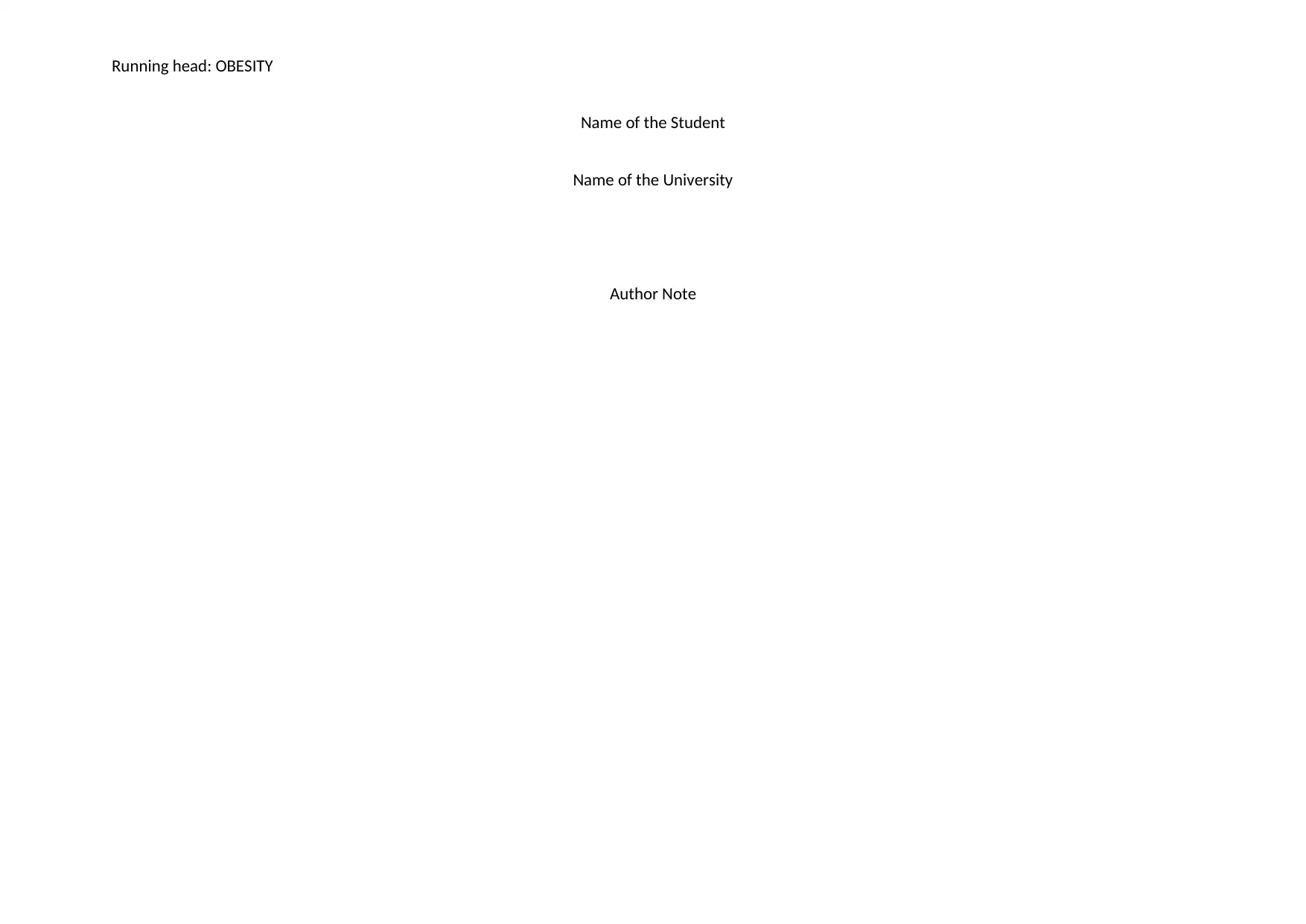
Running head: OBESITY
Name of the Student
Name of the University
Author Note
Name of the Student
Name of the University
Author Note
Paraphrase This Document
Need a fresh take? Get an instant paraphrase of this document with our AI Paraphraser
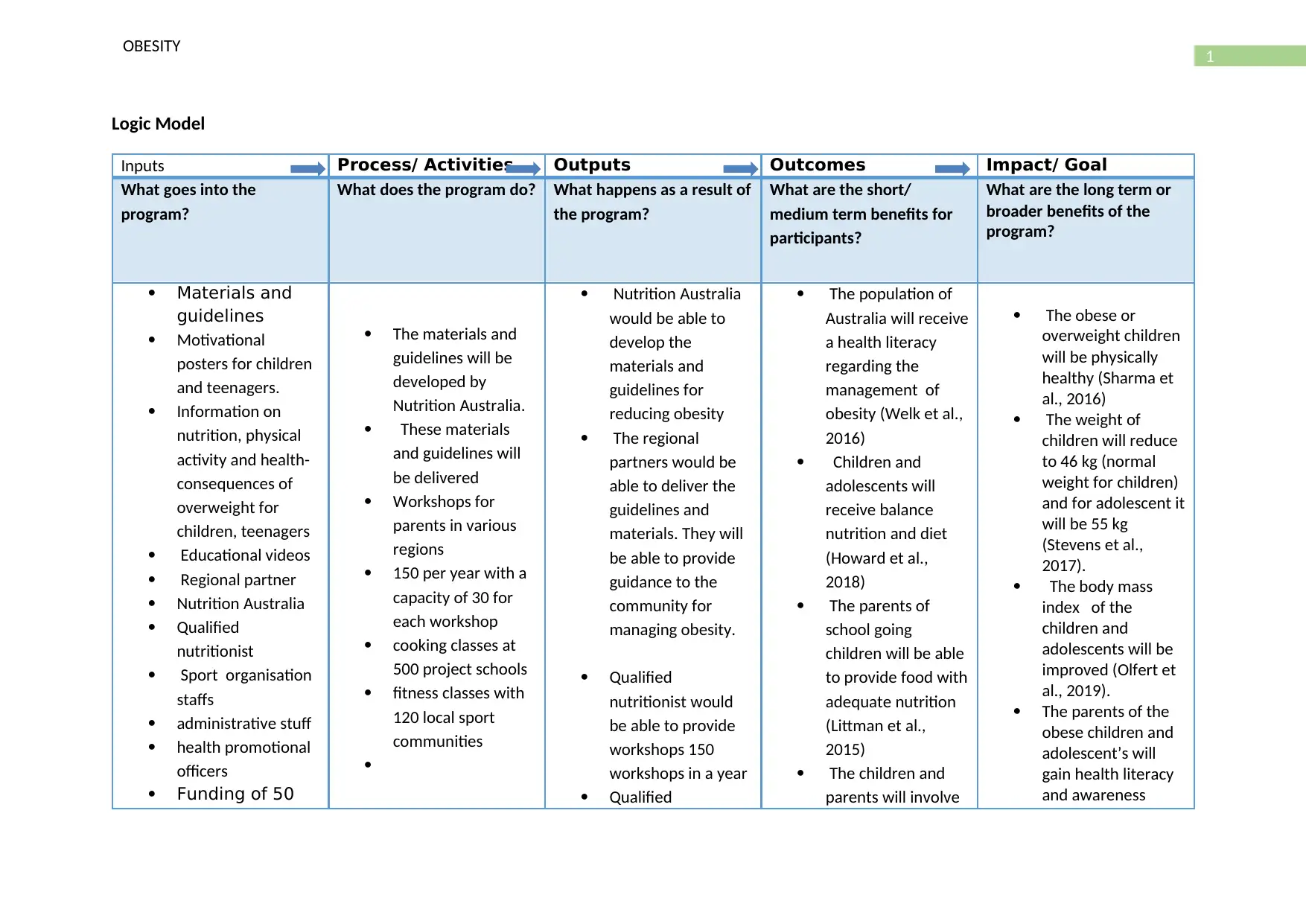
1
OBESITY
Logic Model
Inputs Process/ Activities Outputs Outcomes Impact/ Goal
What goes into the
program?
What does the program do? What happens as a result of
the program?
What are the short/
medium term benefits for
participants?
What are the long term or
broader benefits of the
program?
Materials and
guidelines
Motivational
posters for children
and teenagers.
Information on
nutrition, physical
activity and health-
consequences of
overweight for
children, teenagers
Educational videos
Regional partner
Nutrition Australia
Qualified
nutritionist
Sport organisation
staffs
administrative stuff
health promotional
officers
Funding of 50
The materials and
guidelines will be
developed by
Nutrition Australia.
These materials
and guidelines will
be delivered
Workshops for
parents in various
regions
150 per year with a
capacity of 30 for
each workshop
cooking classes at
500 project schools
fitness classes with
120 local sport
communities
Nutrition Australia
would be able to
develop the
materials and
guidelines for
reducing obesity
The regional
partners would be
able to deliver the
guidelines and
materials. They will
be able to provide
guidance to the
community for
managing obesity.
Qualified
nutritionist would
be able to provide
workshops 150
workshops in a year
Qualified
The population of
Australia will receive
a health literacy
regarding the
management of
obesity (Welk et al.,
2016)
Children and
adolescents will
receive balance
nutrition and diet
(Howard et al.,
2018)
The parents of
school going
children will be able
to provide food with
adequate nutrition
(Littman et al.,
2015)
The children and
parents will involve
The obese or
overweight children
will be physically
healthy (Sharma et
al., 2016)
The weight of
children will reduce
to 46 kg (normal
weight for children)
and for adolescent it
will be 55 kg
(Stevens et al.,
2017).
The body mass
index of the
children and
adolescents will be
improved (Olfert et
al., 2019).
The parents of the
obese children and
adolescent’s will
gain health literacy
and awareness
OBESITY
Logic Model
Inputs Process/ Activities Outputs Outcomes Impact/ Goal
What goes into the
program?
What does the program do? What happens as a result of
the program?
What are the short/
medium term benefits for
participants?
What are the long term or
broader benefits of the
program?
Materials and
guidelines
Motivational
posters for children
and teenagers.
Information on
nutrition, physical
activity and health-
consequences of
overweight for
children, teenagers
Educational videos
Regional partner
Nutrition Australia
Qualified
nutritionist
Sport organisation
staffs
administrative stuff
health promotional
officers
Funding of 50
The materials and
guidelines will be
developed by
Nutrition Australia.
These materials
and guidelines will
be delivered
Workshops for
parents in various
regions
150 per year with a
capacity of 30 for
each workshop
cooking classes at
500 project schools
fitness classes with
120 local sport
communities
Nutrition Australia
would be able to
develop the
materials and
guidelines for
reducing obesity
The regional
partners would be
able to deliver the
guidelines and
materials. They will
be able to provide
guidance to the
community for
managing obesity.
Qualified
nutritionist would
be able to provide
workshops 150
workshops in a year
Qualified
The population of
Australia will receive
a health literacy
regarding the
management of
obesity (Welk et al.,
2016)
Children and
adolescents will
receive balance
nutrition and diet
(Howard et al.,
2018)
The parents of
school going
children will be able
to provide food with
adequate nutrition
(Littman et al.,
2015)
The children and
parents will involve
The obese or
overweight children
will be physically
healthy (Sharma et
al., 2016)
The weight of
children will reduce
to 46 kg (normal
weight for children)
and for adolescent it
will be 55 kg
(Stevens et al.,
2017).
The body mass
index of the
children and
adolescents will be
improved (Olfert et
al., 2019).
The parents of the
obese children and
adolescent’s will
gain health literacy
and awareness
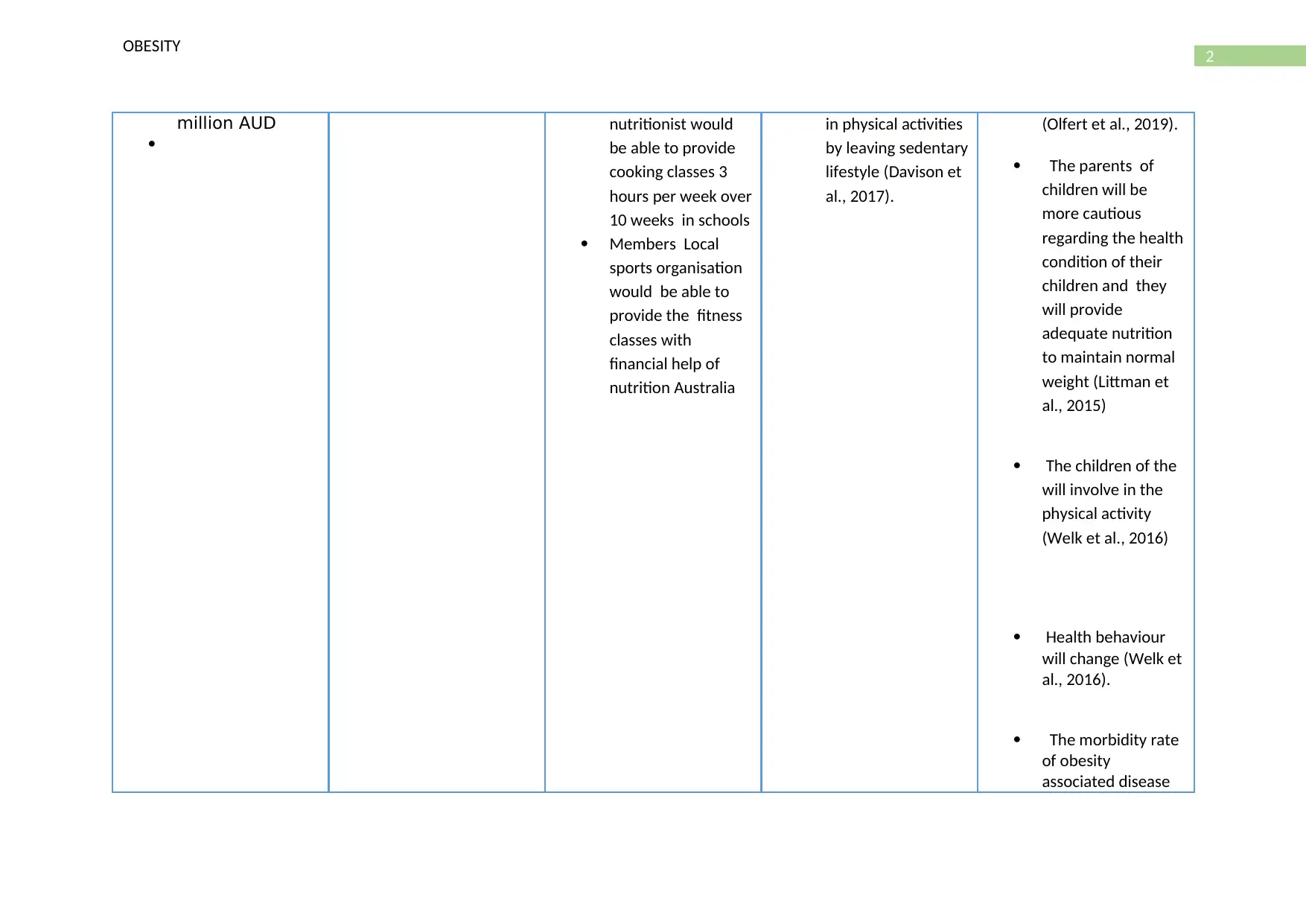
2
OBESITY
million AUD
nutritionist would
be able to provide
cooking classes 3
hours per week over
10 weeks in schools
Members Local
sports organisation
would be able to
provide the fitness
classes with
financial help of
nutrition Australia
in physical activities
by leaving sedentary
lifestyle (Davison et
al., 2017).
(Olfert et al., 2019).
The parents of
children will be
more cautious
regarding the health
condition of their
children and they
will provide
adequate nutrition
to maintain normal
weight (Littman et
al., 2015)
The children of the
will involve in the
physical activity
(Welk et al., 2016)
Health behaviour
will change (Welk et
al., 2016).
The morbidity rate
of obesity
associated disease
OBESITY
million AUD
nutritionist would
be able to provide
cooking classes 3
hours per week over
10 weeks in schools
Members Local
sports organisation
would be able to
provide the fitness
classes with
financial help of
nutrition Australia
in physical activities
by leaving sedentary
lifestyle (Davison et
al., 2017).
(Olfert et al., 2019).
The parents of
children will be
more cautious
regarding the health
condition of their
children and they
will provide
adequate nutrition
to maintain normal
weight (Littman et
al., 2015)
The children of the
will involve in the
physical activity
(Welk et al., 2016)
Health behaviour
will change (Welk et
al., 2016).
The morbidity rate
of obesity
associated disease
⊘ This is a preview!⊘
Do you want full access?
Subscribe today to unlock all pages.

Trusted by 1+ million students worldwide
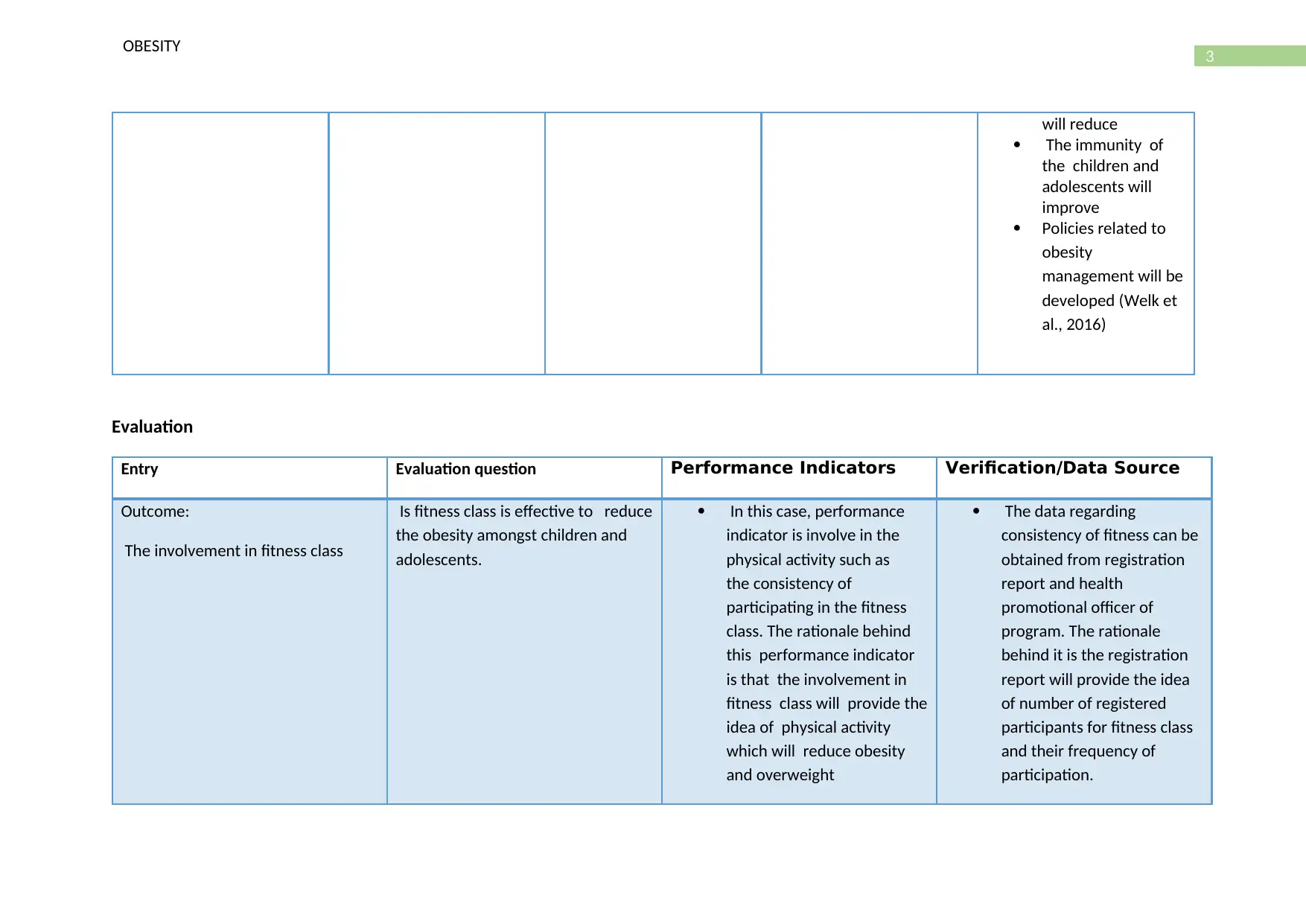
3
OBESITY
will reduce
The immunity of
the children and
adolescents will
improve
Policies related to
obesity
management will be
developed (Welk et
al., 2016)
Evaluation
Entry Evaluation question Performance Indicators Verification/Data Source
Outcome:
The involvement in fitness class
Is fitness class is effective to reduce
the obesity amongst children and
adolescents.
In this case, performance
indicator is involve in the
physical activity such as
the consistency of
participating in the fitness
class. The rationale behind
this performance indicator
is that the involvement in
fitness class will provide the
idea of physical activity
which will reduce obesity
and overweight
The data regarding
consistency of fitness can be
obtained from registration
report and health
promotional officer of
program. The rationale
behind it is the registration
report will provide the idea
of number of registered
participants for fitness class
and their frequency of
participation.
OBESITY
will reduce
The immunity of
the children and
adolescents will
improve
Policies related to
obesity
management will be
developed (Welk et
al., 2016)
Evaluation
Entry Evaluation question Performance Indicators Verification/Data Source
Outcome:
The involvement in fitness class
Is fitness class is effective to reduce
the obesity amongst children and
adolescents.
In this case, performance
indicator is involve in the
physical activity such as
the consistency of
participating in the fitness
class. The rationale behind
this performance indicator
is that the involvement in
fitness class will provide the
idea of physical activity
which will reduce obesity
and overweight
The data regarding
consistency of fitness can be
obtained from registration
report and health
promotional officer of
program. The rationale
behind it is the registration
report will provide the idea
of number of registered
participants for fitness class
and their frequency of
participation.
Paraphrase This Document
Need a fresh take? Get an instant paraphrase of this document with our AI Paraphraser
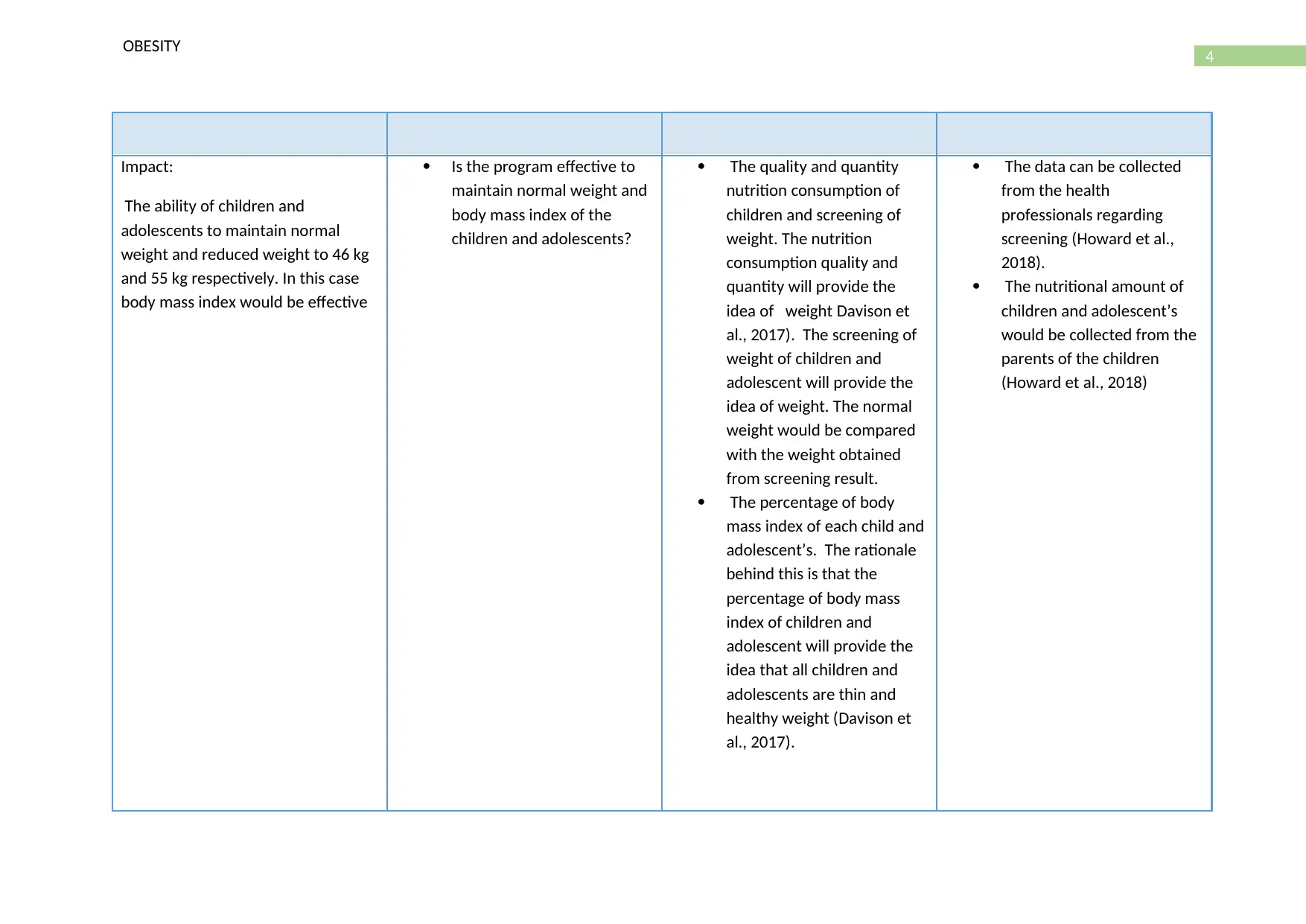
4
OBESITY
Impact:
The ability of children and
adolescents to maintain normal
weight and reduced weight to 46 kg
and 55 kg respectively. In this case
body mass index would be effective
Is the program effective to
maintain normal weight and
body mass index of the
children and adolescents?
The quality and quantity
nutrition consumption of
children and screening of
weight. The nutrition
consumption quality and
quantity will provide the
idea of weight Davison et
al., 2017). The screening of
weight of children and
adolescent will provide the
idea of weight. The normal
weight would be compared
with the weight obtained
from screening result.
The percentage of body
mass index of each child and
adolescent’s. The rationale
behind this is that the
percentage of body mass
index of children and
adolescent will provide the
idea that all children and
adolescents are thin and
healthy weight (Davison et
al., 2017).
The data can be collected
from the health
professionals regarding
screening (Howard et al.,
2018).
The nutritional amount of
children and adolescent’s
would be collected from the
parents of the children
(Howard et al., 2018)
OBESITY
Impact:
The ability of children and
adolescents to maintain normal
weight and reduced weight to 46 kg
and 55 kg respectively. In this case
body mass index would be effective
Is the program effective to
maintain normal weight and
body mass index of the
children and adolescents?
The quality and quantity
nutrition consumption of
children and screening of
weight. The nutrition
consumption quality and
quantity will provide the
idea of weight Davison et
al., 2017). The screening of
weight of children and
adolescent will provide the
idea of weight. The normal
weight would be compared
with the weight obtained
from screening result.
The percentage of body
mass index of each child and
adolescent’s. The rationale
behind this is that the
percentage of body mass
index of children and
adolescent will provide the
idea that all children and
adolescents are thin and
healthy weight (Davison et
al., 2017).
The data can be collected
from the health
professionals regarding
screening (Howard et al.,
2018).
The nutritional amount of
children and adolescent’s
would be collected from the
parents of the children
(Howard et al., 2018)

5
OBESITY
OBESITY
⊘ This is a preview!⊘
Do you want full access?
Subscribe today to unlock all pages.

Trusted by 1+ million students worldwide
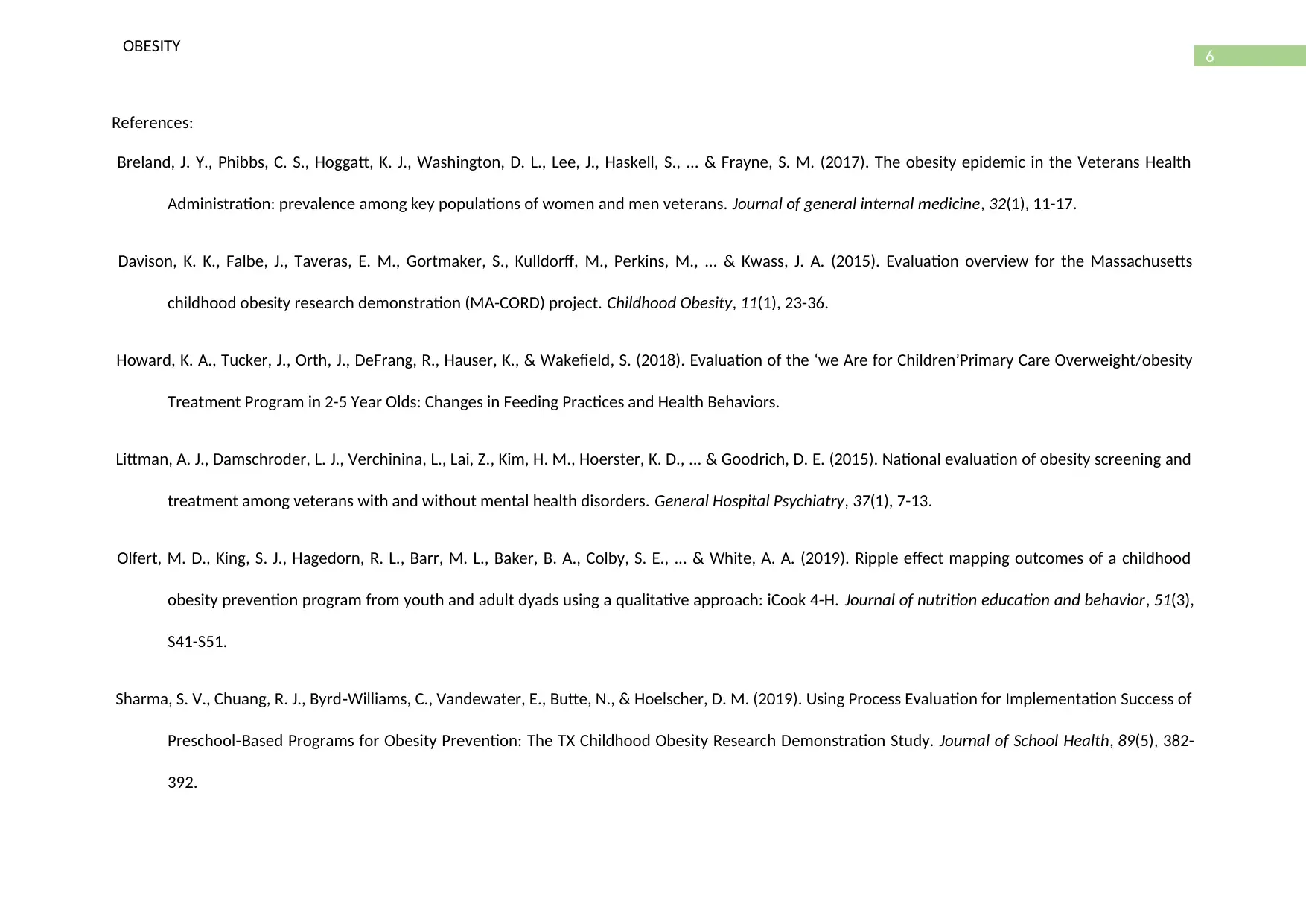
6
OBESITY
References:
Breland, J. Y., Phibbs, C. S., Hoggatt, K. J., Washington, D. L., Lee, J., Haskell, S., ... & Frayne, S. M. (2017). The obesity epidemic in the Veterans Health
Administration: prevalence among key populations of women and men veterans. Journal of general internal medicine, 32(1), 11-17.
Davison, K. K., Falbe, J., Taveras, E. M., Gortmaker, S., Kulldorff, M., Perkins, M., ... & Kwass, J. A. (2015). Evaluation overview for the Massachusetts
childhood obesity research demonstration (MA-CORD) project. Childhood Obesity, 11(1), 23-36.
Howard, K. A., Tucker, J., Orth, J., DeFrang, R., Hauser, K., & Wakefield, S. (2018). Evaluation of the ‘we Are for Children’Primary Care Overweight/obesity
Treatment Program in 2-5 Year Olds: Changes in Feeding Practices and Health Behaviors.
Littman, A. J., Damschroder, L. J., Verchinina, L., Lai, Z., Kim, H. M., Hoerster, K. D., ... & Goodrich, D. E. (2015). National evaluation of obesity screening and
treatment among veterans with and without mental health disorders. General Hospital Psychiatry, 37(1), 7-13.
Olfert, M. D., King, S. J., Hagedorn, R. L., Barr, M. L., Baker, B. A., Colby, S. E., ... & White, A. A. (2019). Ripple effect mapping outcomes of a childhood
obesity prevention program from youth and adult dyads using a qualitative approach: iCook 4-H. Journal of nutrition education and behavior, 51(3),
S41-S51.
Sharma, S. V., Chuang, R. J., Byrd Williams, C., Vandewater, E., Butte, N., & Hoelscher, D. M. (2019). Using Process Evaluation for Implementation Success of‐
Preschool Based Programs for Obesity Prevention: The TX Childhood Obesity Research Demonstration Study.‐ Journal of School Health, 89(5), 382-
392.
OBESITY
References:
Breland, J. Y., Phibbs, C. S., Hoggatt, K. J., Washington, D. L., Lee, J., Haskell, S., ... & Frayne, S. M. (2017). The obesity epidemic in the Veterans Health
Administration: prevalence among key populations of women and men veterans. Journal of general internal medicine, 32(1), 11-17.
Davison, K. K., Falbe, J., Taveras, E. M., Gortmaker, S., Kulldorff, M., Perkins, M., ... & Kwass, J. A. (2015). Evaluation overview for the Massachusetts
childhood obesity research demonstration (MA-CORD) project. Childhood Obesity, 11(1), 23-36.
Howard, K. A., Tucker, J., Orth, J., DeFrang, R., Hauser, K., & Wakefield, S. (2018). Evaluation of the ‘we Are for Children’Primary Care Overweight/obesity
Treatment Program in 2-5 Year Olds: Changes in Feeding Practices and Health Behaviors.
Littman, A. J., Damschroder, L. J., Verchinina, L., Lai, Z., Kim, H. M., Hoerster, K. D., ... & Goodrich, D. E. (2015). National evaluation of obesity screening and
treatment among veterans with and without mental health disorders. General Hospital Psychiatry, 37(1), 7-13.
Olfert, M. D., King, S. J., Hagedorn, R. L., Barr, M. L., Baker, B. A., Colby, S. E., ... & White, A. A. (2019). Ripple effect mapping outcomes of a childhood
obesity prevention program from youth and adult dyads using a qualitative approach: iCook 4-H. Journal of nutrition education and behavior, 51(3),
S41-S51.
Sharma, S. V., Chuang, R. J., Byrd Williams, C., Vandewater, E., Butte, N., & Hoelscher, D. M. (2019). Using Process Evaluation for Implementation Success of‐
Preschool Based Programs for Obesity Prevention: The TX Childhood Obesity Research Demonstration Study.‐ Journal of School Health, 89(5), 382-
392.
Paraphrase This Document
Need a fresh take? Get an instant paraphrase of this document with our AI Paraphraser
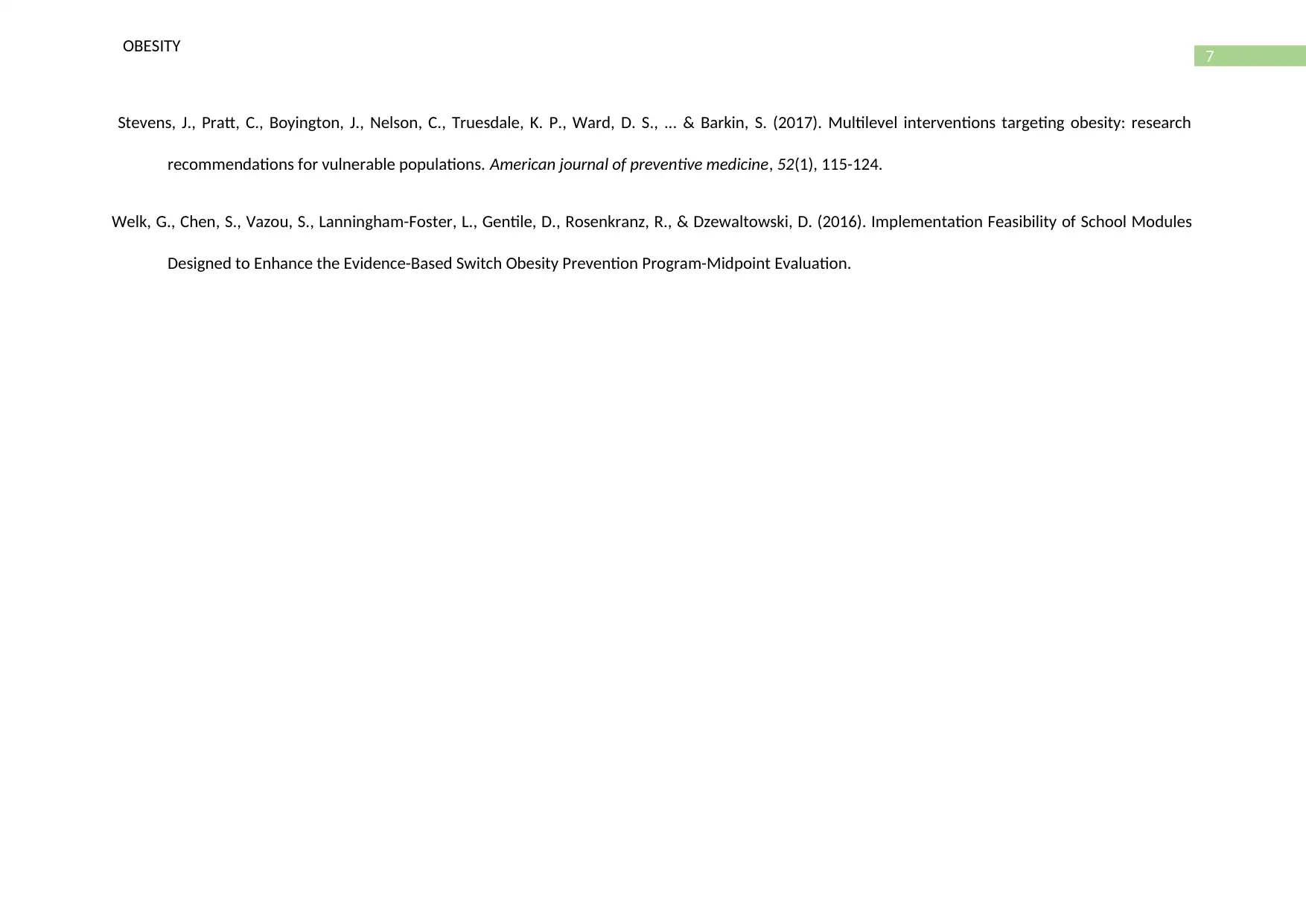
7
OBESITY
Stevens, J., Pratt, C., Boyington, J., Nelson, C., Truesdale, K. P., Ward, D. S., ... & Barkin, S. (2017). Multilevel interventions targeting obesity: research
recommendations for vulnerable populations. American journal of preventive medicine, 52(1), 115-124.
Welk, G., Chen, S., Vazou, S., Lanningham-Foster, L., Gentile, D., Rosenkranz, R., & Dzewaltowski, D. (2016). Implementation Feasibility of School Modules
Designed to Enhance the Evidence-Based Switch Obesity Prevention Program-Midpoint Evaluation.
OBESITY
Stevens, J., Pratt, C., Boyington, J., Nelson, C., Truesdale, K. P., Ward, D. S., ... & Barkin, S. (2017). Multilevel interventions targeting obesity: research
recommendations for vulnerable populations. American journal of preventive medicine, 52(1), 115-124.
Welk, G., Chen, S., Vazou, S., Lanningham-Foster, L., Gentile, D., Rosenkranz, R., & Dzewaltowski, D. (2016). Implementation Feasibility of School Modules
Designed to Enhance the Evidence-Based Switch Obesity Prevention Program-Midpoint Evaluation.
1 out of 8
Related Documents
Your All-in-One AI-Powered Toolkit for Academic Success.
+13062052269
info@desklib.com
Available 24*7 on WhatsApp / Email
![[object Object]](/_next/static/media/star-bottom.7253800d.svg)
Unlock your academic potential
Copyright © 2020–2025 A2Z Services. All Rights Reserved. Developed and managed by ZUCOL.





